Creating a Steam Shower in Home Designer
Pro | Architectural
QUESTION
Is there a way to create a steam shower in my Home Designer software?

ANSWER
In Home Designer Pro and Home Designer Architectural, custom wall types can be defined to create rooms or areas like a steam shower. In this article we will show you how to define a vapor-resistant wall type, and how to design this style of shower.
To define the wall types
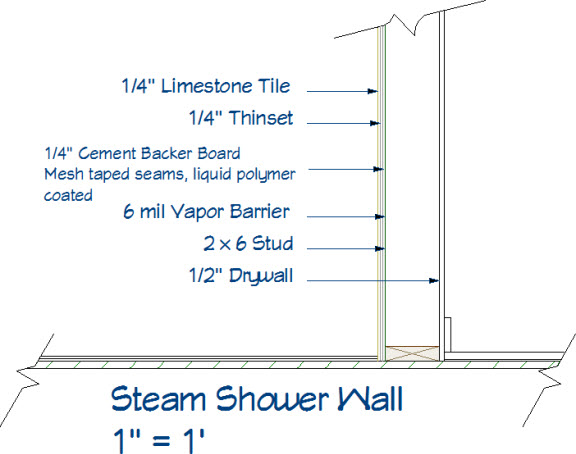
A vapor-resistant wall needs to at least meet the following criteria in the most common cases;
- A surface layer of tile.
- A layer of thinset mortar.
- Cement Backer Board with mesh taped seams.
- Vapor barrier.
- Stud framing.
- Drywall.
The wall type shown in this article is based on the common structure for a wall of this type. It is always best to refer to the building codes in your area for the correct structure of a vapor-resistant wall.
- Click Build> Wall> Define Wall Types
 from the menu.
from the menu.
- In the Wall Type Definitions dialog that displays, click the New button to create a new wall type.
- Name this wall Steam Shower - Interior, add five additional layers by selecting the Insert Below button, and define the wall as follows:
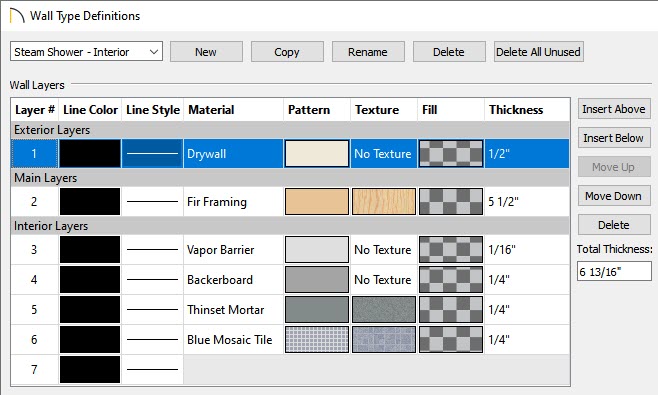
-
Exterior Layers
- Layer 1: Drywall - 1/2".
-
Main Layers
- Layer 2: Fir Framing - 5 1/2"
-
Interior Layers
-
Layer 3: Vapor Barrier - 1/16"
-
Layer 4: Backerboard - 1/4"
-
Layer 5: Thinset Mortar - 1/4"
-
Layer 6: Tile of your choosing - 1/4"
-
Layer 3: Vapor Barrier - 1/16"
-
Exterior Layers
- Repeat the process to create a second wall type. This wall type however, will be called Steam Shower - Exterior and the Exterior Layers section will have a siding material layer, along with an OSB layer, instead of drywall.
You are now ready to draw your bathroom and steam shower. In this example, we will start with the standard default wall tools, then change the bathroom walls to use the new vapor-resistant wall type(s) mentioned above.
"The wall layers just defined have drywall on the exterior of what appears to be an exterior wall. Are these layers defined correctly? The exterior layer should be at the top of the diagram."
This simply means that the program sees the wall type created contains characteristics of an exterior wall, which would not typically have the exterior layer to be made of drywall. You can safely click OK and continue with the rest of this article.
To draw a steam shower
- Select Build> Wall> Straight Exterior Wall
 and/or Straight Interior Wall
and/or Straight Interior Wall  from the menu, then draw an area to represent the bathroom.
from the menu, then draw an area to represent the bathroom.

- Using the Select Objects
 tool, select the room and click the Open Object
tool, select the room and click the Open Object  edit tool.
edit tool.
- On the General panel of the Room Specification dialog that displays, change the Room Type to Bath, then click OK.
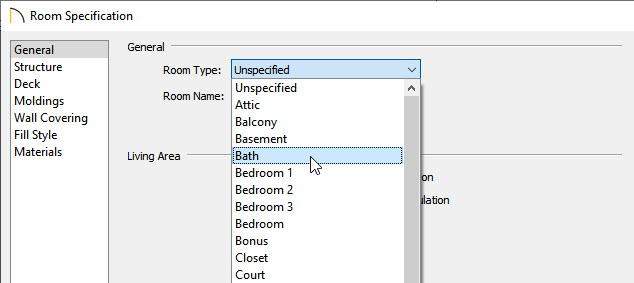
- Next, navigate to Build> Wall> Straight Glass Wall
 or Straight Glass Pony Wall
or Straight Glass Pony Wall  from the menu, and add two additional walls in the corner to form the area that will serve as the steam shower.
from the menu, and add two additional walls in the corner to form the area that will serve as the steam shower.
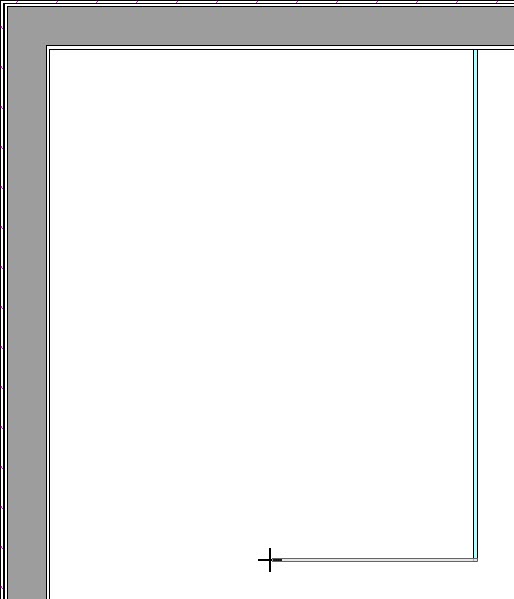
- Navigate to Build> Door> Shower Door
 and click along one of the glass shower walls to place a shower door.
and click along one of the glass shower walls to place a shower door.
Select and open the Glass Shower Door to specification to make size modifications, change the applied hardware, adjust arch properties, or to alter other characteristics such as the type of glass that is used.
- Select the left, vertical wall using the Select Objects
 tool, click on the Break
tool, click on the Break  edit button, then click once where the glass shower wall intersects the exterior wall. A break line will be created separating the wall in to two separate segments.
edit button, then click once where the glass shower wall intersects the exterior wall. A break line will be created separating the wall in to two separate segments.
In Home Designer 2020 and prior versions, navigate to Build> Wall> Break Wall instead, then click on the wall intersection you'd like to break.
instead, then click on the wall intersection you'd like to break.

- Place an additional break point on the top horizontal wall where the glass shower wall intersects.
- Next, select the left, vertical wall segment that is part of the shower, Open
 it to specification, and on the General panel of the Wall Specification dialog, change the Wall Type to the Steam Shower - Exterior wall type that was created earlier in this article. This can be changed on the Wall Types panel in Home Designer Pro.
it to specification, and on the General panel of the Wall Specification dialog, change the Wall Type to the Steam Shower - Exterior wall type that was created earlier in this article. This can be changed on the Wall Types panel in Home Designer Pro.
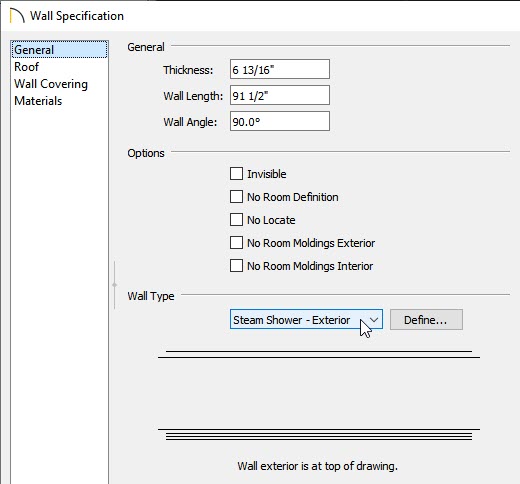
- Perform the same procedure to change the top horizontal wall that's part of the shower to use the Steam Shower - Interior wall type. Do this only for walls that will be shared with other rooms in the structure.
Your plan may now look similar to the image below.

We are now ready to adjust the floor and ceiling properties of the steam shower.
To define the floor and ceiling
- Click Build> Roof> Ceiling Plane
 . Using the Select Objects
. Using the Select Objects  tool, select the steam shower room and click the Open Object
tool, select the steam shower room and click the Open Object  edit tool.
edit tool.
- On the Structure panel of the Room Specification dialog that displays:
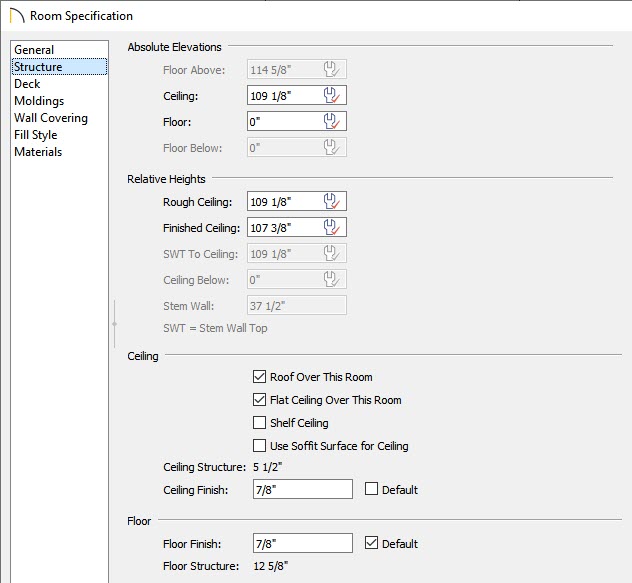
- Adjust the Ceiling height of the steam shower to your liking.
- Adjust the Ceiling Finish and Floor Finish values.
- In some cases, a sloped ceiling is generated for steam showers to prevent dripping in unwanted areas due to condensation. If you would like to have a sloped ceiling above the steam shower, uncheck the Flat Ceiling Over This Room checkbox and the ceiling will follow the pitch that is specified for the roof.
- Adjust the Ceiling height of the steam shower to your liking.
-
On the Moldings panel, add or remove any moldings to the shower.
- On the Materials panel, modify the materials for the Ceiling Finish, Floor Finish, and the other components for the steam shower, then click OK to close the dialog.
- Add any additional Library
 accessories to the shower such as faucets, drains, and shower heads.
accessories to the shower such as faucets, drains, and shower heads.
- Faucets can be located at Home Designer Core Catalogs> Architectural> Fixtures> Faucets.
- Shower pans can be located at Home Designer Core Catalogs> Architectural> Fixtures> Showers> Shower Pans.
- Steam shower components such as steam heads, ports, glass wall components, and control panels can be located in the Bathroom Fixtures No.4 Shower Hardware bonus catalog located in the 3D Library.
- Additional sauna accessories such as benches and other seating components can be located in the Poolside and Sauna bonus catalog located in the 3D Library.
- Faucets can be located at Home Designer Core Catalogs> Architectural> Fixtures> Faucets.
- Lastly, create a Camera
 view to see the results.
view to see the results.